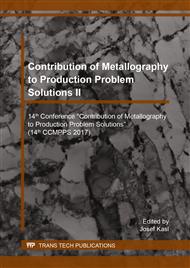p.212
p.218
p.224
p.230
p.239
p.246
p.253
p.258
p.265
Effects of Heat Treatment on Microstructure of High-Strength Manganese-Silicon Steels
Abstract:
Today’s advanced steels are required to possess high strength and ductility. This can be accomplished by producing appropriate microstructures with a certain volume fraction of retained austenite. The resulting microstructure depends on material’s heat treatment and alloying. High ultimate strengths and sufficient elongation levels can be obtained by various methods, including quenching and partitioning (Q&P process). The present paper introduces new procedures aimed at simplifying this process with the use of material-technological modelling. Three experimental steels have been made and cast for this investigation, whose main alloying additions were manganese, silicon, chromium, molybdenum and nickel. The purpose of manganese addition was to depress the Ms and Mf temperatures. The Q&P process was carried out in a thermomechanical simulator for better and easier control. The heat treatment parameters were varied between the sequences and their effect on microstructure evolution was evaluated. They included the cooling rate, partitioning temperature and time at partitioning temperature. Microstructures including martensite with strength levels of more than 2000 MPa and elongation of 10–15 % were obtained.
Info:
Periodical:
Pages:
239-245
Citation:
Online since:
November 2017
Authors:
Keywords:
Price:
Сopyright:
© 2017 Trans Tech Publications Ltd. All Rights Reserved
Share:
Citation:


